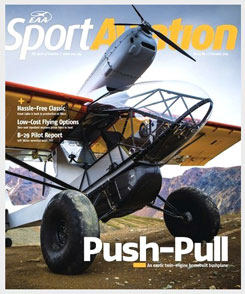
NEW Great Lakes
to Include a Second Aircraft Design
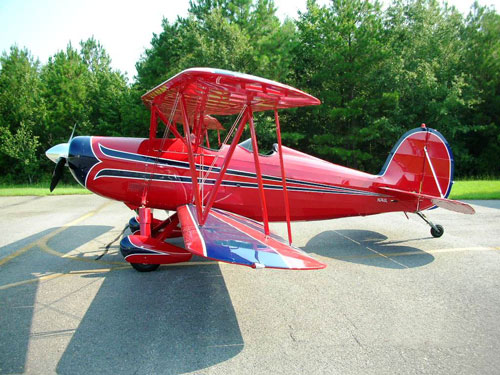


The design and construction techniques are very similar to the current Waco YMF-5D biplane produced by Waco Classic; however, the airplane is smaller and features simple avionics and systems. Several improvements to the earlier design are planned, including changing from the current wood spar to a new aluminum spar, upgrading the brakes, avionics updates and serviceability improvements.
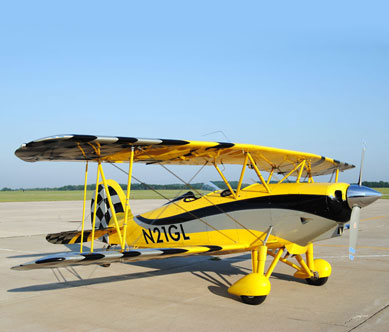
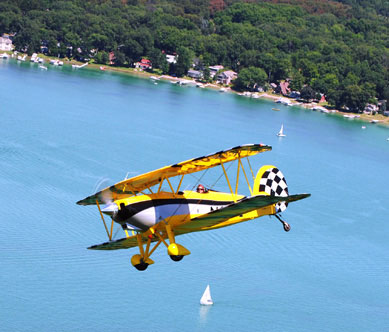
(see text below)

Peter Bowers likes to revive and update 1930s vintage biplanes—first the Waco, now the Great Lakes
By Bill Cox, Photos By Jim Koepnick
Time flies, and so do I when I’m having fun. Call me a purist, but flying an open-cockpit biplane has always seemed the simplest and most elemental form of aviating. Over the years, I’ve been fortunate to fly a dozen or so open-cockpit machines, all but one of them biplanes, and nearly all dedicated to one form or another of flight training.
The Great Lakes was the first of those classic designs. “My” occasional rental biplane was a truly tired machine based in Compton, Calif., in the early 1970s. Dan Rihn, builder of a single-place Pitts in the hangar next to mine at Compton and an engineer for Northrop in the real world, shared the rental with me of that barely flyable, old Great Lakes as we explored basic aerobatics off the Southern California coast. We’d rent for an hour and trade off a few minutes at a time, complete a short sequence, then hand off the biplane with a shake of the stick.
Dan went on to become a star in the aerobatic world, conceiving the DR-1 One Design and competing in the Unlimited aerobatic class, but we both had plenty of laughs learning a little about acro in the 2T-1A biplane.
Fast-forward 40 years to the 2014 Sun ‘n Fun air show in Lakeland, Fla. Peter Bowers, owner of Waco Classic Aircraft in Battle Creek, Mich., had dreamed of reviving the Great Lakes design for years. In case you hadn’t guessed by the company name, Bowers is the power and direction behind the revival of the Waco YMF-5, and the new Great Lakes 2T-1A-2 is the result of his vision and belief in the salability of another classic biplane.
Bowers didn’t rise to own an aircraft company by making stupid decisions, and for that reason, he chose to incorporate only those changes to the Great Lakes that related to safety and system integrity, and didn’t demand recertification. He knew that recertifying the Great Lakes for more power, an enclosed canopy, additional fuel or other major changes could tie up government certification for years and cost multiple millions.
The Great Lakes dates back to 1929, when a Cleveland company initiated production with an 85 hp engine. That original manufacturer went bankrupt in 1933, and a succession of owners have attempted to revive the model ever since. The airplane was offered again in the ‘70s and ‘80s with essentially the same engine and prop as today’s improved model. That project went bust in 1985, and the tooling and jigs have been dormant ever since.
Bowers felt the Great Lakes could be an excellent entry-level airplane for his Waco artisans in Battle Creek. He contacted John Duncan, then owner of the 2T-1A-2 type certificate, and arranged to purchase all rights for the biplane and put it back into production.
To that end, Bowers elected to make nearly a dozen minor and some not-so-minor upgrades. “Inside the cockpit, we made a number of improvements to increase pilot and passenger comfort,” Bowers explained. “Most important was probably a better heater, a major consideration on any open-cockpit airplane. Nearly everyone hated the original heel brakes, so we installed more conventional toe brakes in the rear cockpit. We also reclined the pilot’s seat four inches to provide more room. We increased the height of both windscreens to deflect more wind. Back in the rear cockpit, we improved the panel by incorporating several of the combination instruments available on today’s market versus mounting an individual instrument for each function.”
There were a number of other functional changes to the new Great Lakes. Waco Classic split the nose bowl to allow engine maintenance without having to remove the prop. “Some owners of the earlier airplanes complained that the fabric fuselage sides around both cockpits took a beating and had to be replaced often,” said Bowers, “and we solved that by metalizing the fuselage from the firewall to aft of the rear pit. Another common complaint was leaking hydraulic seals on the landing gear, so we changed those out to a tighter, more reliable seal.
“Additionally, we improved construction on the horizontal stabilizer spars, switching from aluminum to steel, enlarged the oil cooler for hot-weather operation and added LED lights,” says the CEO. “The end product was a more comfortable airplane with better serviceability.”
Fortunately, the best of what went before still remains. Climbing aboard the Great Lakes isn’t much of a stretch, even if you’re not quite as agile as you used to be. Left foot goes on the boarding step at mid-fuselage, left hand grabs the grip at the trailing edge of the top wing; then, you swing your right leg into the rear pit, step on the seat, fold in your other leg and lower yourself into position, being careful never to grip the Plexiglas windshield for support.
Space inside the aft pit is more generous than it appears from the outside. I’m fairly broad shouldered, enough so that I barely fit into the aft cockpit of a Pitts S2C, and the Great Lakes was comparatively very comfortable. The five-point harness and wide, nylon, aerobatic lap belt attaches you to the airplane and provides a sensation of security without making you feel constricted. Overall, it’s far more comfortable than you might imagine.
All controls fall readily to hand, with the throttle/prop/mixture quadrant even with the bottom of the panel and the rope trim system slightly below that on the left. Rope trim may seem antediluvian compared to the electro-hydraulic systems on modern airplanes, but at only 1,800 pounds gross—barely 150 pounds more than the last Cessna 150—the airplane’s elevator needs little trim, and the rope method works remarkably well. Fuel feeds from a single 27.4-gallon tank mounted in the top wing, so it’s either on or off, the simplest possible fuel system possible.
Baggage goes aboard into a tiny compartment that’s part of the rear cockpit’s pilot headrest, and weight limit is 10 pounds—toiletries only. If you needed to fly cross-country in a Great Lakes and didn’t have anyone riding up front, you could strap in a small suitcase or mount a 10-gallon aux tank in the front seat for an extra hour of endurance. That would boost total fuel to 37.4 gallons.
The big, comfortable stick produces Gs with light pressure, and you can’t help but feel like a
World War I ace.
Panel layout on the company’s serial number 001 demonstrator is characteristic of the standard panel on all new Great Lakes. Engine condition instruments are combined in the JPI EDM-930 at far right, and a Garmin Aera 560 takes care of navigation, moving map display, traffic information and weather, plus an ADS-B datalink at far left. A remarkably small Trig VHF radio provides communication and transponder capability, and two big three-inch instruments—airspeed and altimeter—top center panel. A G-meter and small yaw coordinator complete the instrument/avionics package.
Standard engine on the 2T-1A-2 is a Lycoming AEIO-360-B1G6, a 180 hp mill with an inverted fuel and oil system, capable of sustaining inverted flight for up to three minutes—about two minutes, 50 seconds more than most people can stand. (If you should decide to turn downside up, you’ll need a fairly high negative angle of attack to maintain level flight.)
Takeoff with a 10:1 power and wing loading is always fun, and the Great Lakes pops its tailwheel off the ground quickly and hustles to liftoff in minimum space, typically less than 500 feet at sea level. Hold a climb speed of 80 mph, and the biplane will loft uphill at 1,200-1,400 fpm.
I staged out of the grass runway at South Lakeland Airport during the last day of the Sun ‘n Fun Fly-In and headed south to stay clear of the airshow at Lakeland Linder field. I let the airplane drift up to 3,000 feet for some stalls, but after some slow flight and preliminary nibbles at stall characteristics, it was obvious I might as well have skipped them entirely. Power-off stalls are a total non-event in the Great Lakes, more reminiscent of a Maule’s gentle downhill mush than the abrupt break you might expect of an aerobatic biplane. Power-on stalls are similarly unexciting, though the combined area of the four wings allowed me to hold about 40 degrees of pitch with no tendency to break left or right.
Control harmony on the Great Lakes is excellent, with just the right amount of response between pitch, roll and yaw. Predictably, elevator response is quickest. The big, comfortable stick produces Gs with light pressure, and you can’t help but feel like a World War I ace when you launch into acro.
In the aerobatic mode, the magic number for practically everything is 125 mph. That’s barely into the bottom of the yellow, so G-stress on the airplane is minimal. You’ll notice Waco Classic uses mph rather than knots. That’s mandated by the airplane’s Bulletin 7A certification that preceded even the later CAA 3C designation. Mph seems somehow only appropriate on an airplane with roots in the 1920s. It may seem an antiquated measure in aviation, but mph is, after all, only a number, as valid as 95 knots or 200 kilometers per hour.
With four ailerons contributing to the roll rate, the Great Lakes offers a complete rotation in less than four seconds, suggesting a max stick deflection roll of about 100 degrees/second. The maneuver couldn’t be much simpler; dive to 125 mph, nose up to 15 degrees above the horizon, pause long enough to unload the airplane; then add slight rudder and full stick in the desired direction, and hold on. The airplane is also capable of slow rolls, barrel rolls, point rolls, snaps, loops and hammerhead turns, plus combination maneuvers such as split Ss, Cuban 8s, Immelmanns, spins and loops with a snap on top. G limits are +5.4 to -4.0.
Loops are as simple and unchallenging as aileron rolls. Accelerate to the magic 125 mph, pull to 3.0-3.5 Gs, and monitor the upline by watching the wingtips. Then, throw your head back and pick up the inverted horizon coming over the top, ease off the back pressure to go slightly negative and avoid flying a written “l”, then recover on the downline. Even if you pull too hard and stall the airplane at any point in the maneuver, you can recover by simply easing off on the back pressure. Whether you’re a beginner at acro or a little more experienced, the Great Lakes will always make you look better than you are.
Throughout the experience, there’s that indefinable magic of being one with the wind, and that alone seems almost worth the price of admission ($245,000). Since we were flying in south Florida in 80 degree weather, there was no need for the heater, but experience in the front, open cockpit of Waco’s YMF-5 suggests it puts out plenty of BTUs in cold weather.
Landings defy the stereotype of the squirrelly taildragger. There are no flaps, so you control glide with a slip if you’re high. That’s also an excellent idea on any approach in the Great Lakes, as there’s little forward visibility looking straight ahead, even if you’re riding in the front cockpit. See 70-75 on the airspeed, kick out the slip at the bottom, and the airplane settles into a nose high flare and touches asphalt or grass as if it has done the same thing a thousand times before.
There are few options on the Great Lakes. The only significant extra is an MT composite prop that weighs 17 pounds less than the stock Hartzell and sells for $8,900. Bowers reports that all seven of the advance orders have opted for the lightweight prop.
The Great Lakes was designed primarily as a trainer that could teach both basic entry-level aviating and gentleman’s aerobatics, and there’s a school in Arizona, Chandler Air Service, that employs four of the older airplanes for earning the private license from hour one to the ticket. Can you imagine a better way to learn to fly than in a Great Lakes biplane?
The new 2T-1A-2 isn’t handicapped by relatively high altitude, either. Service ceiling is 17,000 feet, though it’s hard to imagine why anyone would fly an open-cockpit biplane at three-and-a-half miles altitude. You’d certainly need every bit of the new heater’s capability.
The airplane does its best cruise work at a fairly typical 7,500 feet where 75% power is all there is. With power dialed in and trim set for straight and level, the Great Lakes delivers about 120 mph. Contrary to what you might imagine, the view from on high is magnificent. That may seem a contradiction in an open cockpit biplane with wings, wheels, cabanes, struts and wires all over the place. In the Great Lakes, all the obstacles seem to enhance rather than detract from visibility.
In fact, the new Great Lakes has so many positives, its few negatives shrink to insignificance. The craftsmanship is outstanding; the airplane flies acro better than it has any right to and performance is generally excellent.
But, if for some reason you decide not to buy the Great Lakes 2T-1A-2, remember that there’s only one other open-cockpit, two-place production biplane on the market—Waco Classic’s round-engine YMF-5—and Peter Bowers would be happy to sell you one of those.








(click on the cover below to download a pdf of the article)

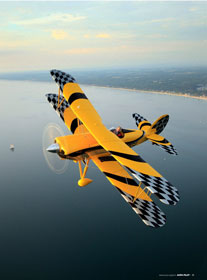
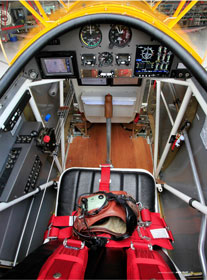
(click on the cover below to go to the ONLINE ARTICLE.
Then click to go to page 56 for the article, "History Without Hassle.")
